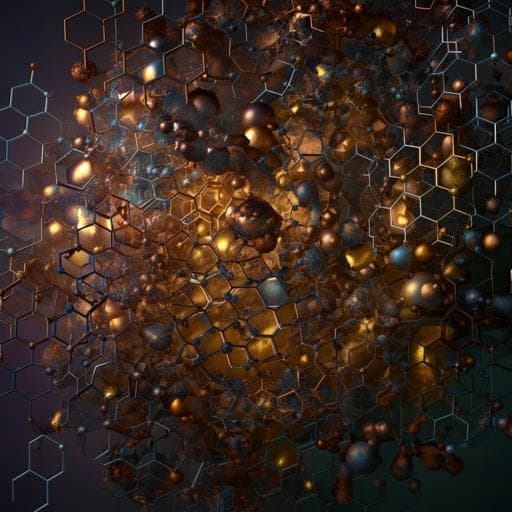
Physics
Distinct switching of chiral transport in the kagome metals KV<sub>3</sub>Sb<sub>5</sub> and CsV<sub>3</sub>Sb<sub>5</sub>
C. Guo, M. R. V. Delft, et al.
Discover the fascinating interplay between charge order and superconductivity in kagome metals AV3Sb5 (A = K, Rb, Cs). This groundbreaking research by Chunyu Guo and collaborators unveils the significant difference in electric magneto-chiral anisotropy between CsV3Sb5 and KV3Sb5, emphasizing the role of correlated states and environmental interactions.
~3 min • Beginner • English
Introduction
Kagome metals host Dirac points and potentially flat bands, leading to correlated and topological phenomena including large anomalous Hall effects and protected boundary states. The AV3Sb5 (A = K, Rb, Cs) family exhibits a charge-density-wave (CDW) transition at approximately 100 K and superconductivity at low temperatures. A key open question is which symmetries are broken in the CDW state, particularly time-reversal and mirror symmetries. Experimental indications include electronic C2 anisotropy, chiral CDW textures from STM, and three-state nematicity in Kerr measurements. A direct transport signature of broken mirror symmetry is electrical magneto-chiral anisotropy (eMChA), previously observed and field-switchable in CsV3Sb5, implying an electronically controlled chirality rather than fixed structural chirality. The research question is whether eMChA is a general property across AV3Sb5 and what microscopic factors control it, addressed by a side-by-side comparison of CsV3Sb5 and KV3Sb5 under low-strain, high-field transport measurements and band-structure analysis.
Literature Review
Prior work established AV3Sb5 as kagome metals with CDW order and unconventional superconductivity. Reports suggest broken rotational and mirror symmetries in the CDW state: electronic C2 anisotropy, chiral CDW observed by STM, and three-state nematicity seen in Kerr effect studies. Electrical magneto-chiral anisotropy has been demonstrated in structurally chiral conductors and, notably, found to be field-switchable in CsV3Sb5, suggesting an electronically induced chirality. For KV3Sb5, STM studies reported rotational-symmetry-breaking chiral charge order, but conclusions on magnetic-field control of chirality have been contradictory. Fermiology of CsV3Sb5 has been extensively characterized via quantum oscillations and magnetotransport; KV3Sb5 has been less studied. Theoretical DFT calculations show similar band structures among the A-site variants due to shared P6/mmm space group and V kagome nets, with subtle differences near the M point. These works motivate a controlled comparative transport study focusing on eMChA and its switchability.
Methodology
- Low-strain device architecture: To minimize strain sensitivity of eMChA, crystalline microstructures were mechanically decoupled from the substrate by lithographic ultra-soft membrane springs (100 nm SiN, 150 nm Au) acting as supports and electrical contacts. One current lead was fixed to the Si substrate via FIB-assisted Pt deposition to reduce torque distortion at high fields; other contacts were supported by the springs. The central Hall-bar microstructure (long axis along c) was carved from single crystals using focused ion beam (FIB) milling.
- Materials synthesis: CsV3Sb5 single crystals were grown following established procedures. KV3Sb5 crystals were grown by self-flux (K:V:Sb = 7:3:14) in an alumina crucible sealed in a Ta tube; heated to 1000 °C, annealed 20 h, cooled to 400 °C at 3 °C/h, then to room temperature; crystals obtained by dissolving flux in water.
- Linear transport characterization: Temperature-dependent resistivity measured in a PPMS (9 T) to identify CDW transitions and residual resistivity; low-temperature superconducting transition checked down to about 2 K.
- High-field magnetotransport: Measurements up to 35 T in a Bitter magnet at HFML using a probe with in-situ rotatable stage to sweep field angle from c to a′ axis; standard lock-in detection (SR830/SR860). Magnetoresistance background fitted with a third-order polynomial to extract Shubnikov–de Haas (SdH) oscillations and determine quantum oscillation frequencies versus angle.
- Nonlinear transport and eMChA detection: eMChA probed via second-harmonic voltage V2ω generation under low-frequency AC currents. Chiral contribution to conductance Δσ inferred from V2ω/V, with sign and magnitude tracked versus magnetic field B and tilt angle across the kagome planes to test field-switchability.
- Electronic structure calculations: Ab initio DFT (Quantum ESPRESSO, GGA-PBE with appropriate pseudopotentials) performed without including CDW reconstruction to compare the baseline band structures and Fermi surfaces of CsV3Sb5 and KV3Sb5. Calculated Fermi-surface features at A and H points compared to experimental angular quantum oscillation frequencies (approximately following F ∝ 1/cosθ for quasi-2D sheets).
- Additional observables: Angular magnetoresistance scans to identify in-plane spikes associated with coherent interlayer transport and 3D pocket contributions, contrasted between Cs and K compounds.
Key Findings
- Similar fermiology: DFT band structures of CsV3Sb5 and KV3Sb5 are qualitatively similar, consistent with shared P6/mmm structure and V kagome nets. Quantum oscillation frequencies in both materials disperse in lockstep with angle, indicating comparable Fermi surfaces with quasi-2D branches around 1700 T and 700 T; several low-frequency (below 500 T) 3D features appear near in-plane fields. The large Brillouin-zone pocket around I was not observed experimentally.
- CDW and superconductivity: Resistivity anomalies identify T_CDW ≈ 94 K (CsV3Sb5) and 76 K (KV3Sb5). KV3Sb5 exhibits a broader CDW transition, higher residual resistivity, and no superconducting transition down to approximately 2 K in the measured device (reported Tc can be as low as ~0.7 K in literature), consistent with higher vacancy/disorder levels.
- Robust, non-saturating eMChA in CsV3Sb5: Second-harmonic voltage V2ω exhibits a strong, non-saturating, field-asymmetric response exceeding 4 µV at 35 T. Due to non-saturating magnetoresistance, V2ω scales approximately as B^3; the chiral conductance contribution Δσ ∝ V2ω/V is linear in B. The sign of Δσ reverses when the magnetic field is tilted across the kagome plane, demonstrating magnetic-field-switchable electronic chirality tied to the out-of-plane field component. The relative chiral correction ΔR/R reaches about 1.2% at 35 T, with no saturation, implying any crossover lies above this field range.
- Strong suppression and lack of switchability in KV3Sb5: The second-harmonic signal is more than two orders of magnitude smaller than in CsV3Sb5 under comparable conditions and remains essentially unchanged upon tilting B across the kagome planes, indicating an absence of field-switchable chirality and possibly negligible eMChA within experimental sensitivity. Measurement is complicated by potential asymmetric non-Joule heating from imbalanced contact magnetoresistances owing to the tiny signal magnitude.
- Angular magnetoresistance contrast: CsV3Sb5 shows a pronounced spike for nearly in-plane magnetic fields, consistent with coherent interlayer transport and small 3D pockets emerging from CDW reconstruction; this spike is strongly suppressed in KV3Sb5, consistent with enhanced decoherence scattering due to disorder/vacancies.
Discussion
The stark contrast in eMChA between CsV3Sb5 and KV3Sb5 cannot be explained by their similar single-particle band structures and fermiology, pointing to an interacting, correlated-state origin of chiral transport. Elevated vacancy/disorder levels in KV3Sb5 (reflected in higher residual resistivity, weaker SdH oscillations, reduced magnetoresistance, and suppressed in-plane MR spike) likely enhance decoherence and isotropic scattering, impacting electronic order. Several scenarios are considered: (1) If eMChA arises from chiral scattering within an ordered phase, increased achiral scattering could smear but is unlikely to account for the huge difference alone. (2) If chiral transport emerges from chiral domains in the CDW state, vacancies may act as pinning centers that lock a domain pattern with balanced chirality, canceling the net eMChA and preventing magnetic-field switchability. (3) An achiral bulk state in KV3Sb5 remains possible despite STM evidence of chiral order, which might be surface-localized. Subtle electronic differences, phonon spectrum variations, or proximity to competing orders could tip KV3Sb5 into an achiral or unresponsive phase, suppressing eMChA. The pronounced, switchable eMChA in CsV3Sb5 up to 35 T indicates a robust electronically controlled mirror-symmetry breaking, whereas KV3Sb5’s response suggests disorder- or phase-driven suppression, underscoring the critical role of correlations and defects beyond single-particle descriptions.
Conclusion
This work provides a direct, side-by-side comparison of chiral transport in kagome metals CsV3Sb5 and KV3Sb5. Despite similar band structures and fermiology, CsV3Sb5 exhibits strong, non-saturating, and field-switchable eMChA up to 35 T, while KV3Sb5 shows negligible, non-switchable signals. The contrast highlights that the V kagome nets alone do not determine low-temperature chiral transport; instead, correlated electronic states and their sensitivity to disorder and environment are decisive. Future research should systematically tune disorder and carrier concentration (e.g., via Sn substitution, controlled K vacancies, or electron irradiation) to discriminate between single-particle scattering versus domain-pinning scenarios. Probing higher magnetic fields to test for overcoming domain pinning energies near threshold doping, and detailed studies of phonon spectra and possible surface-bulk distinctions, could further clarify the origin of electronic chirality in AV3Sb5.
Limitations
- The DFT calculations do not include CDW reconstruction, providing only the baseline band structures.
- The extremely small second-harmonic signal in KV3Sb5 complicates detection and is susceptible to artifacts such as asymmetric non-Joule heating from imbalanced contact magnetoresistances, making it challenging to ascertain the presence of any intrinsic eMChA.
- Measurements are limited to fields up to 35 T; potential saturation or crossovers at higher fields remain unexplored.
- Possible surface-bulk discrepancies (e.g., chiral order confined to surfaces) are not resolved by the bulk transport measurements.
- Disorder/vacancy levels in KV3Sb5 are likely higher but not independently quantified in the same devices, limiting direct correlation between defect density and eMChA suppression.
Related Publications
Explore these studies to deepen your understanding of the subject.







